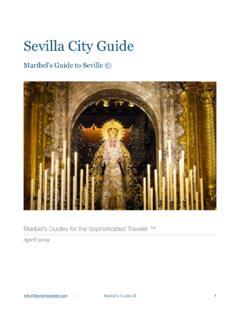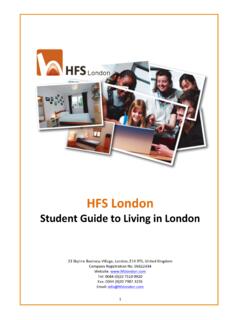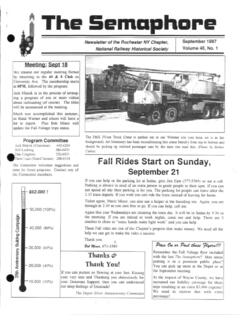Transcription of Contents: 1978
1 Contents: 1978. Page No. Para. Ref. Purpose .. 1 1. Useful Points to get Over to the Public .. 1 Sample .. 3 2. Address List .. 3 3. Counting Households at the Address and Empty Households 3 4. Multi Household Addresses .. 3 5. a) Pre-sampled multi-household addresses .. 4 Multi-households: special cases .. 6 b) Concealed multi-households .. 7 Extra households .. 7 Household about to move .. 8 6. Households temporarily resident at address .. 8 7. Excluded Addresses .. 8 8. Household Definition .. 9 9. Head of Household Definition .. 10 10. Housewife Definition .. 10 10. Spender Definition .. 10 11. Applying the Definition of Spender in varying circumstances.
2 10 12. Absence of Spenders during the fortnight .. 10 Changes in Household Composition during the Record Keeping Period ..+.. 11 Spacing of placing cal 1s over the fieldwork period .. 12 13. Non-contact addresses .. 13 Extension of placing work beyond the,month .. 13 14. Weekly quota of four - what is included .. 13 15. Procedure with each co-operating household .. 14 16. First call ..- ..O 14 17. The interview call .. 15 Starting date of records .. 15 18 . Before the first checking call .. 15 19. Checking calls .. 15 20. Final call .. 16 21. The Purpose Leaflet .. 16 22..,. Page No. Para. Ref. Payments to co-operating members .. 16 23. Method of payment.
3 17 Revisiting a household after the final call for further detai 1s .. 17 24. Detailed Points on Schedules .. 17 25. A Schedule -inquestion number order .. 19 26. B Schedule - Introduction and requirements ..,. 34 27. ,, ,, -Order of person numbers .. 34 00 ,, - in question number order .. 35 D Schedule .. 43 28. ,' ,, - points to remember .. 43 ?-! ,, ,, !. - Details required .. 43 -. -/. Checking Schedules .. 48 H Form - Weekly return of households .. 50 30. E Form - Record of Spenders in co-operating hlds only .. 50 31. F Form - Record of Outcome at each HH other than co-operating HH .. 50 32. J Form - Despatch note .. 50 33. Recorded Del ivery .. 50 33.
4 Order of Documents .. 51 34. Study Time Allowance .. 51 Clerical Time Allowance .. 52 Contact with HQduring field period .. 52 35. Index .. 53. The lines in the left- hand margin indicate changes in wording or content from the 1977. Field Instructions. CLIENT AND PURPOSE. 1. Of all the many surveys the Social Survey has conducted, the Family Expenditure Survey is probably the most widely used by the House of Commons and by government departments as a basis for econanic policy decisions. It is a continuous survey which the Social Survey has conducted ever since January 1957 for the Department of Employment. Although the survey has many uses, its primary function is to provide data which forms the basis for the annual revision of the weightst of the Index of Retail Frices.
5 It is the Index (often referrsd to as the 1 Cost of Living Indax?) which is published each month in the Department of Employment!s jGazette ,and which is, in turn, widely quotsd in the Press and on Television. Useful Points to Get Over to the Public i) This survey is carried out in connection with the annual revision of the Index of Retail Frices. It provides a list of goods and ssrvices used by most households and the proportions ( weights1). each represents in the average familyt budget. In addition, a selection of itsms are priced each month by the Department of ?ilnployment and the average family budget recalculated to see how much more it is costing to buy the same list of goods and services.
6 Ii) Of particular intsrest to the elderly is the fact that the survey provides data on pensioner household expenditure, ie. the two Retail Frice indices for one-person and two-person pensionsr households. These indices show how pensioner households are affected by price changes and thsrefore form the basis for policy decisions to improve pensioner benefits. iii) Departments other than the Department of Employment use the FES. as the only continuous source of info~ation on household expenditure and inccme. The FM is regularly quoted as a source in the House of Commons. iv) The following are some recent examples of uses of the FES by gOv=rnment departments. (Uses of the FES by government depart- ments may be quoted as and when vou feel thev.
7 Mav . be of interest to infOr&nts 1). a) The survey shows to what extent diffsrent types of households cOn@ibute tO the State in Income Tax, Value Added Tax and other taxes. It also demonstrates in what ways these house- holds benefit from such things as education, pensions, and social services. (Central Statistical Office). b) to examine expenditure on bus fares, train fares and private cars by households with different incnmes (Department of Transport). c) to examine consumption and expenditure on gas and electricity y by households at different income levels (Department of Energy). d) to provide data on consumerst expenditure and income for cliff erent regions, eg Wales, the South East (Central Statistical Office).
8 1. 1,.y?~' ;. e) to study resources and needs of two and one-parent families and the costing of child and family benefits (Department of Health and Social Security). f) to study the take-up of means-tested social security benefits (Department of Health and Social Security). g ) tO study the take-up of rent and rates rebates (Department of the Environment). v) The Index and data from tbe FES are also used by organisations outside government, such as trade unions, local authorities, industries, market research agencies and academic institutions. Some examples are: a) Wage negotiations: some industries set their wages automatically by changes in the Retail Frice Index.
9 B) Certain Pension schemes are Index-linked. c) Certain investments like SAYE and National Savings Retirement .T. certificates (for old age pensioners) are linkad to the Index. r,. : d) The Office of Fair Trading studies trends in installmentcredit using the FES as its source. e) The FES provides analyses of household income and expenditwe to Royal Commissions. f) Consultants and other bodies engaged in market research use the FES to examine patterns of expenditure on particular types of goods and services; (they can then advise clients on the likely size of markets for particulw goods);. g) Detailed patterns of both household incomes and expenditure (in particular on housing and transport) are provided to local authorities and New Town Corporations.
10 This will help to suggest where new local services should be situated and how extensive they should be. (To ensure reliability, such information is not provided fo~ areas smaller than Greater London and the regions). 2. The Sample The sample of addresses is drawn from 56 local authority districts each mnnth. In the course of a year each of these districts is used four times at three monthly intervals and is then replaced. The districts are rotated in such a way that 14 of the 56 districts are replaced by new selections each month. Altogether 168 districts are coversd in a quarter and nearly 300 in 12. months. The addresses are selected from a different ward on each of the four occasions that the district is used.






